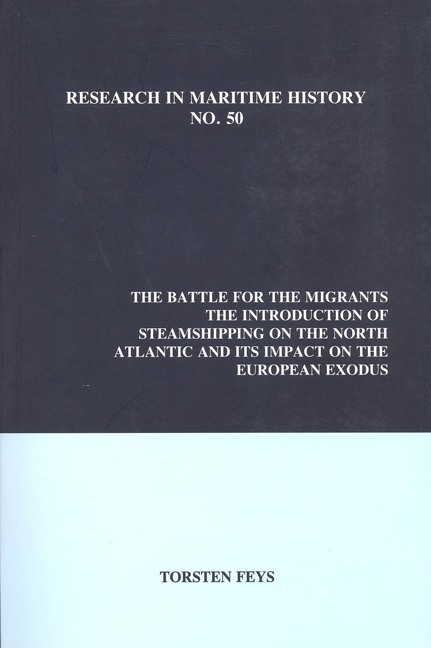 The Battle for the Migrants
The Battle for the Migrants Book contents
- Frontmatter
- Contents
- About the Author
- Acknowledgements
- Figures and Tables
- Introduction
- Part I State Policies and Their Influence on the Connections between Maritime and Migration Networks, 1830-1870
- Part II The Impact of Steam Shipping on Transatlantic Migration, 1870-1914
- Chapter 1 The Role of Middlemen
- Chapter 2 Competition and Collusion: The Growing Pains of Passenger Shipping Conferences
- Chapter 3 The IMM Merger and Further Consolidations in the Shipping Industry
- Chapter 4 The Nationalization of American Migration Policies and the Visible Hand of the Shipping Lobby
- Chapter 5 Shipping Companies' Interference with the Enactment and Implementation of Immigration Laws during the Progressive Era
- Conclusion
- Appendices
Conclusion
from Part II - The Impact of Steam Shipping on Transatlantic Migration, 1870-1914
- Frontmatter
- Contents
- About the Author
- Acknowledgements
- Figures and Tables
- Introduction
- Part I State Policies and Their Influence on the Connections between Maritime and Migration Networks, 1830-1870
- Part II The Impact of Steam Shipping on Transatlantic Migration, 1870-1914
- Chapter 1 The Role of Middlemen
- Chapter 2 Competition and Collusion: The Growing Pains of Passenger Shipping Conferences
- Chapter 3 The IMM Merger and Further Consolidations in the Shipping Industry
- Chapter 4 The Nationalization of American Migration Policies and the Visible Hand of the Shipping Lobby
- Chapter 5 Shipping Companies' Interference with the Enactment and Implementation of Immigration Laws during the Progressive Era
- Conclusion
- Appendices
Summary
Approaching nineteenth-century transatlantic mass migration as a trade issue adds to our understanding about the business structures that sustained chainmigration patterns, the structural development of passenger lines into cartels turning migrant transport into a big business and the origins, development and enforcement of early migration laws. Placing the steamship companies at the heart of the European mass migration story underlines their pivotal role in enabling, facilitating and stimulating the process.
Transatlantic business networks were entangled in the transnational chain-migration networks through which a majority of migrants moved. Migrant agents and brokers represent key “meso” level figures connecting both. The focus on the American market underlines the importance of established immigrant entrepreneurs in ethnic enclaves within this process. Sharing the same background put them in a privileged position to gain the trust of coethnics who depended on them for key services to fulfil their migration strategies. Bringing people from Europe formed part of these. Through prepaid tickets the agent connected the purchaser with the shipping company and local agents in Europe. Together they arranged inland transport to the port of embarkation and supplied the passenger with information on how to overcome barriers along the way. At these barriers and key transit points, other agents provided assistance to ensure that passengers arrived for their scheduled sailing. Besides assisting with the move, migrant agents played an important role as distributors of information on opportunities in the US, on ways to reach and finance the trip to various destinations, on laws regulating the passage and how to circumvent them and on conditions in the home country to stimulate sales in the US. They promoted ocean passage sales directly with continual advertisements in the popular press on both sides of the Atlantic at their own cost. Often migrant agents published their own newspaper whose subscriber lists served to extend their customer base. Lists of potential clients were used to send letters containing promotional material and to direct canvassers and peddlers. Personal contacts and forms of direct marketing were fundamental to gain the confidence of customers.
It was not so much the prospect of financial gains on ticket sales but rather the crucial importance of this migrant service to develop and attract other business opportunities that made this product attractive to migrant entrepreneurs in the US.
- Type
- Chapter
- Information
- The Battle for the MigrantsThe Introduction Of Steamshipping On The North Atlantic And Its Impact On The European Exodus, pp. 315 - 322Publisher: Liverpool University PressPrint publication year: 2012


